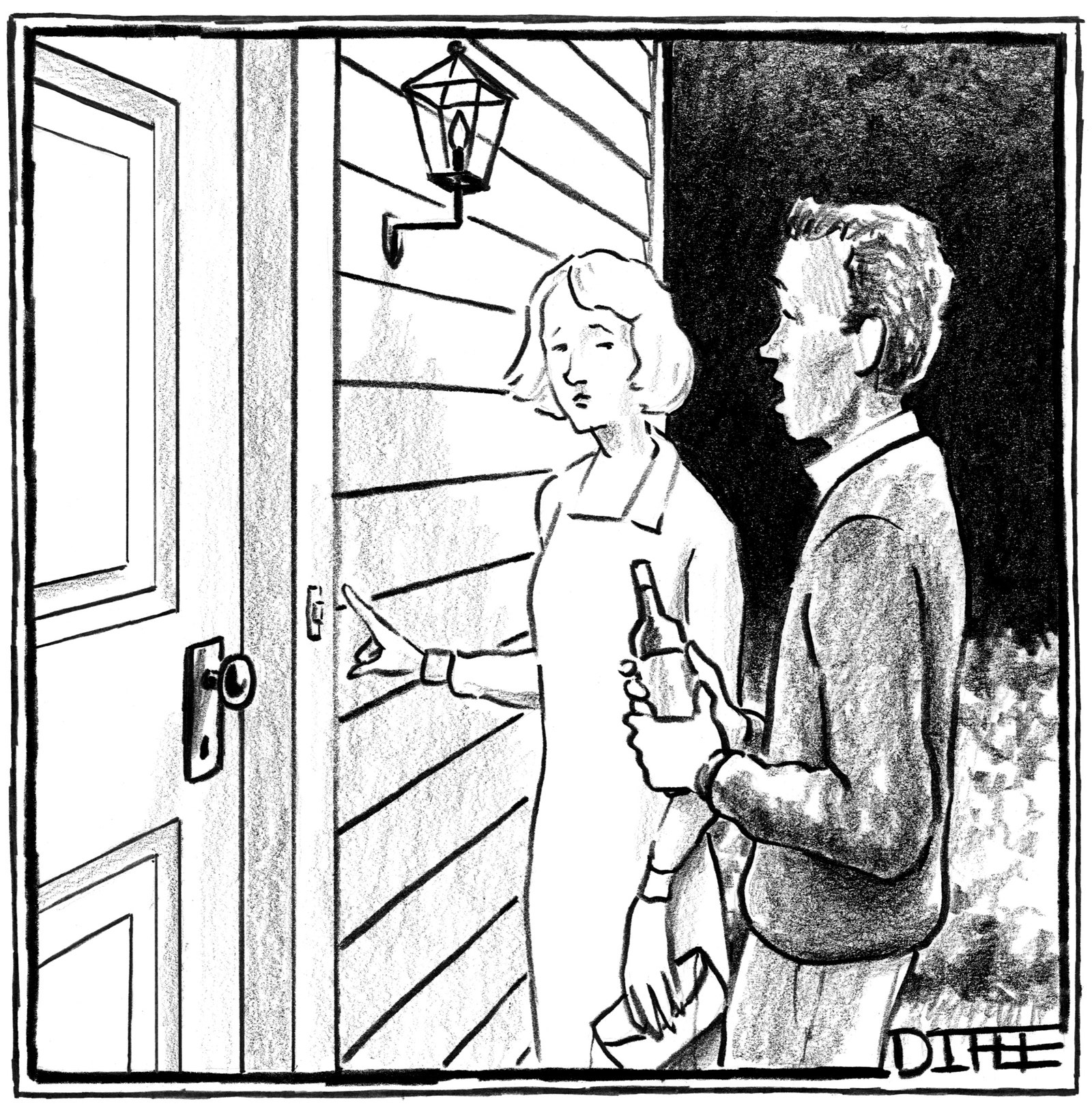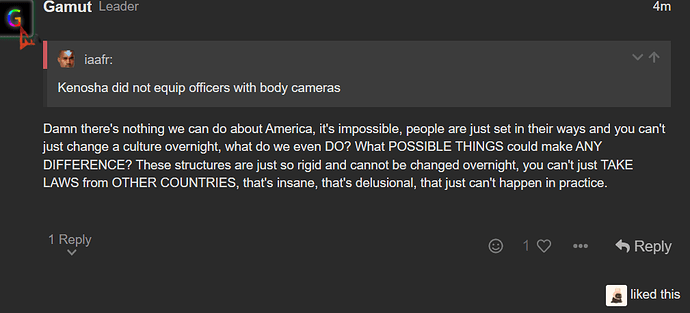The Rittenhouses say that they didn’t know who either Pappas or Tarrio was at the time. Hancock, who has become one of the family’s advisers, says that neither he nor the Rittenhouses grasped the meaning of “Proud of Your Boy” or the “O.K.” gesture, and didn’t realize that any of the men at Pudgy’s were Proud Boys. Though Hancock is a security professional, he told me that he hadn’t learned the names of the men who had volunteered as lookouts or invited Rittenhouse to the bar. Explicit clues about the men’s affiliations existed in plain sight. When I examined the Pudgy’s surveillance footage, I noticed “Proud Boy” tattooed on one man’s forearm; another man had a tattoo of the rooster weathervane from the Proud Boys logo.
The insurrection at the U.S. Capitol occurred the next day. Federal authorities have charged numerous presumed Proud Boys, including one alleged organizer, Ethan Nordean, who had publicly praised Rittenhouse as a “stud.” Lin Wood had tweeted that Vice-President Mike Pence should be executed by firing squad, and would later call him a “TRAITOR, a Communist Sympathizer & a Child Molester.” On the morning of the attack, Wood tweeted, “The time has come Patriots.”
Six days after the Capitol assault, Rittenhouse and his mother flew with Pierce to Miami for three days. The person who picked them up at the airport was Enrique Tarrio—the Proud Boys leader. Tarrio was Pierce’s purported client, and not long after the shootings in Kenosha he had donated a hundred dollars or so to Rittenhouse’s legal-defense fund. They all went to a Cuban restaurant, for lunch.
The Rittenhouses would not say what was discussed at the meal. Hancock, who wasn’t there, clearly understood that it didn’t look good. He insisted to me that the Rittenhouses were uncomfortable with the meeting, and blamed Pierce for orchestrating the encounter and exposing Rittenhouse “to elements that hurt him.” Hancock, who told me that the Proud Boys are “fucking losers,” said that Rittenhouse initially “may have thought it was kind of cool to see people fighting for him, but when he learned what they were all about it didn’t sit well with him.” He added, “He’s just as horrified by the white-supremacist part of it as anybody.”
The Miami lunch did not become publicly known. But the next day the prosecutors in Kenosha filed a motion—based on the surveillance footage from Pudgy’s—asking the court to make it a condition of Rittenhouse’s bond that he avoid contact with “known members of any violent white power / white supremacist groups.”
The Rittenhouses stayed at a Courtyard Marriott in Coral Gables. According to Hancock, the family didn’t see Tarrio again. The court soon accepted the modification to Rittenhouse’s bond agreement, and also restricted him from possessing or consuming alcohol.
Rittenhouse fired Pierce, via FaceTime, on February 1st. Since then, Hancock told me, he has advised the family to reject overtures from other extremist figures and to stop appearing on right-wing media programs. Meanwhile, he was battling Wood, who had accused him of hacking #FightBack’s network and taking the donor list. The police chief in Yemassee, South Carolina, where Wood lives, recently issued a felony warrant against Hancock. Hancock denies any wrongdoing.
The Kenosha prosecutors’ petition calling #FightBack a “slush fund” has led Hancock to establish a more conventional trust for the Rittenhouses, modelled on the arrangement that Van Wagner and Goetz described in their e-mail to Wood. According to Hancock, it has so far raised nearly half a million dollars. He told me that most donations are between twenty and fifty dollars, but, citing privacy concerns, he wouldn’t release a list of donors. He also wouldn’t discuss details of his payment agreement with the Rittenhouses. He said of the #FightBack debacle, “It was never meant to become this grossly political B.S. that morphed into ‘election fraud’ and militias adopting Kyle. The point was to fund his criminal defense.”
After breaking with Pierce, the Rittenhouses left Indiana. In April, I met them at their new place, whose location I agreed not to disclose. My request for an interview had repeatedly been refused, but Hancock had facilitated a meeting. There were substantial restrictions: the Rittenhouses would answer questions about their family history, and about such figures as Pierce, but—as is common with homicide defendants—we could not directly discuss the case.
“I’m ready to leave whenever you are.”
Cartoon by Matthew Diffee
When the Rittenhouses fled Antioch, they abandoned most of their possessions. Donors re-outfitted them: their current place had a new sectional sofa, a Keurig coffeemaker, and bed linens from Walmart. Each family member had a bedroom. All three siblings, including Faith, who is twenty, were back in high school, online, and using new computers that Hancock had provided.
Before I arrived, Wendy set out platters of deli meats, and made a dip of cream cheese and canned chili. Rittenhouse was in his room, but Wendy took me to meet him briefly. He had on a dark-blue hoodie and black Lululemon slacks. Behind him were PlayStation controls and a desktop computer. He had been researching where to apply to college, and said that he hoped to go into pediatric nursing. He later explained, “Seeing how my mom and her co-workers work with their patients, and how they treat their families—those people are having the worst day of their lives, and they need somebody to fall onto and rely on. That’s something I want to do.”
In the den, Wendy and Faith sat together on the sofa and Hancock perched at one end. The family clearly hoped to distance themselves from some of the people who had surrounded them. Wendy said of the Rittenhouses’ decision to break with Pierce, “Kyle was John’s ticket out of debt.” She was pressing Pierce to return forty thousand dollars in donated living expenses that she believed belonged to the family, and told me that Pierce had refused: “He said we owed him millions—he ‘freed Kyle.’ ”
The Rittenhouses, with considerable input from Hancock, described Kyle as selfless (“He has this nature to protect people”) and ideologically open-minded (“huge Andrew Yang fan”). The Rittenhouses did not see themselves as particularly political, but Faith considered herself an ardent advocate of Black Lives Matter. I was told that Kyle liked Trump because Trump liked the police.
They insisted that Kyle was not racist, and made a point of explaining that the Rittenhouses have Black relatives. The whole family agreed that the Minneapolis police officer Derek Chauvin had murdered George Floyd, and Faith said that she had attended a march protesting the killing. She had actively disapproved of her brother’s support of Trump, especially given Trump’s misogyny, but said that Rittenhouse knew “how to respect women.” I raised an obvious discrepancy: the punching incident. Wendy said, “I told Kyle, ‘Never hit a girl.’ I also told Kyle, ‘Always defend your sisters.’ ”
The Rittenhouses told me that Kyle used to travel with a combat-grade tourniquet tucked in his boot, and that he had distributed tourniquets to his family. When I asked what he had kept in his first-aid kits, Hancock called him out of his bedroom, and Rittenhouse instantly provided a list: airway kits, tourniquets, QuikClot hemostatic gauze, gloves, splints, bandages, cotton swabs, tweezers, C.P.R. masks—“not the cheap ones.” His determination to appear prepared, or strong, suggested an adolescent’s need to prove himself. At the Antioch police station, he had said, “I’m not a child anymore.”
The night of the shootings, Wendy had a bad feeling, and called Rittenhouse. “I’m doing medical,” he told her. The gunfire started moments later. “That day, I felt a part of me die,” Wendy told me. Faith said, “Because Kyle had to defend himself? And, if he didn’t, he would have died?” Wendy said, “Yeah.” She started to cry: “He didn’t want to kill them!”
Faith overtly acknowledged the deaths. “I’m sorry to the families—we all are sorry,” she said, adding, “We think about it—a lot.” Wendy remained stuck on the idea that if Kyle “didn’t have that gun he’d be dead.” She seemed unwilling to grasp that if a bunch of civilians hadn’t been carrying rifles that night, we wouldn’t be having this conversation.
In 2017, Dwayne Dixon, an anthropologist at the University of North Carolina, heard about an upcoming Ku Klux Klan rally in Durham. He showed up to counter-protest with a semi-automatic rifle. Dixon belonged to Redneck Revolt, whose members believed in arming themselves in self-defense against white supremacists.
The rally never materialized, but the sheriff’s department charged Dixon with two misdemeanors: “going armed to the terror of the people” and carrying a weapon to a demonstration. There was precedent. In 1968, during the civil-rights movement, the North Carolina Supreme Court had upheld the need for restricting loaded weapons, noting, “In this day of social upheaval one can perceive only dimly the tragic consequences to the people if either night riders or daytime demonstrators, fanatically convinced of the righteousness of their cause, could legally arm themselves.” Public safety was jeopardized when firearms were “ready to be used on every outbreak of ungovernable passion.”
But times had changed. The first of Dixon’s charges was dropped, and a judge ultimately dismissed the count of “carrying a weapon,” citing Dixon’s First Amendment and Second Amendment rights.
After arresting Dixon, the sheriff had declared that he could not “ignore the inherent danger that comes with untrained individuals operating as a self-appointed security force in our streets.” The climate has only worsened since then. The Giffords Law Center to Prevent Gun Violence recently began compiling a list of demonstrations that attract visibly armed protesters or counter-protesters. Throughout 2020 and early 2021, there were more than sixty such events, in twenty-four states and in Washington, D.C.
Many state laws supersede city ordinances, making it impossible for cities and towns—even those with rising gun violence—to set constraints on guns. Not long ago, officials in Boulder, Colorado, banned “assault weapons” and high-capacity magazines, but in March a judge blocked the ban, saying that the local government had no control over the extent to which people can be armed in public. Ten days after the judge intervened, a shooter killed ten people at a Boulder grocery store.
In May, Washington State banned civilians from openly carrying firearms at permitted demonstrations. The ban’s primary sponsor, Patty Kuderer, has said, “The purpose of bringing a weapon to a public demonstration is not to protect yourself, it’s to intimidate.” Other states, however, are moving in the opposite direction. Texas, later this year, will allow people to carry handguns without a permit, and in California there are new legal challenges to long-standing bans on AR-15-style weapons and large-capacity magazines. The availability of guns correlates with gun violence. During the ten years of the federal ban on assault weapons—1994 to 2004—the number of mass-shooting events diminished. Last year, the U.S. broke records for gun sales and reached the highest level of gun homicides in decades.
Thirty states have adopted “stand your ground” laws, further institutionalizing civilian use of lethal force. Robyn Thomas, the Giffords Law Center’s executive director, told me that such laws urgently need to be repealed, because, among other things, they distort the notion of civic responsibility: “You have this misconception of a hero with a gun being the answer to public safety, when it’s exactly the opposite.” Armed civilians assume that they are “doing good” partly because “the system propagates that mythology, by passing laws that allow for it.”
In Wisconsin, determining if someone acted in self-defense involves the question of who initiated the aggression. But, as in many states, there is no clear definition of provocation. As John D. Moore explained in a 2013 article in the Brooklyn Law Review , in some parts of the country a person forfeits the privilege of self-defense merely by having shown up at a “foreseeably dangerous situation.” Moore argued that the varying standards make it harder for citizens to “fairly distinguish between the vigilant and the vigilante.” Wisconsin’s law favors someone who “in good faith withdraws from the fight,” yet there is not always a duty to retreat. At Rittenhouse’s trial, which is scheduled to begin on November 1st, the jury may need to find only that when he pulled the trigger he reasonably feared death or great bodily harm.
Many people in Wisconsin expect the jury to determine that the D.A. overreached when he imposed the charge of intentional homicide. Yet Rittenhouse could still go to prison if jurors hold him accountable for the deaths. The Harvard law professor Noah Feldman recently wrote that, though Rittenhouse presumably will claim that he feared having his gun wrested away and used against him, it’s only “the presence of Rittenhouse’s own weapon” that gives him “the opportunity to claim that he was in fear of bodily harm.” Thomas told me that if Rittenhouse hadn’t concluded that it was his responsibility to venture, armed, into a “hot environment,” he “wouldn’t have been in harm’s way, and he certainly wouldn’t have hurt anyone else.”
In a recent hearing, Bruce Schroeder, the judge who will preside over Rittenhouse’s trial, stressed the importance of sticking to “the facts and the evidence.” He demanded “a trial that’s fair to the defendant, which is his constitutional guarantee, and to the public, which is my responsibility.”
But, thanks to the opportunists who have seized on the Rittenhouse drama, the case has been framed as the broadest possible referendum on the Second Amendment. No other legal case presents such a vivid metaphor for the country’s polarization. Many of Rittenhouse’s supporters have described the shootings almost in cathartic terms, as if they were glad that he killed people. If a jury appears to sanction vigilantism, it seems likely that more altercations between protesters and counter-protesters will turn deadly.
Thomas sees the case as “a bellwether,” putting “guns at the forefront of the stability of our democracy.” Protecting citizens’ safety “is a primary function of our government,” she said. “Yet it’s gotten to the point where this idea that you have a right to carry a loaded weapon is starting to literally overtake other rights—the right to express your vote, the right to assemble without fear.” ![]()


